Unit 5: Exploring the Nature of Astronomical Phenomena in the Context of the Sun/Earth/Moon System
IV. Using Central Ideas to Develop Two Explanatory Models For Day And Night
This section develops two models for explaining the daily observation that when the Sun is above the horizon, during day, one can see things, one’s world outside is well lit; after the Sun is below the horizon, during night, one’s world outside is dark unless illuminated by artificial lighting.
Question 5.22 Why does it get dark at night?
Two models offer explanations for why it gets dark at night: the Fixed Earth, Revolving Sun model and the Fixed Sun, Rotating Earth model.
A. Developing the Fixed Earth, Revolving Sun explanatory model for day and night
What does the Sun seem to be doing during a day and night? One can observe the Sun seem to rise in the east in the early morning, climb in an arc until high in the sky at about noon, continue to move across the sky while sinking in an arc, and set in the west before it gets dark at night.
After the sun sets, the sky is dark for many hours. One cannot see where the Sun seems to have gone at night. One could infer, however, that the Sun continues its daily journey of revolving in an arc around the other side of the Earth.
This Earth-centered perspective, with the Sun revolving daily around a fixed Earth, is also known as a geocentric model as shown in Fig. 5.24. The prefix geo- refers to the Earth and centric refers to something that is at the center, something around which other things revolve.
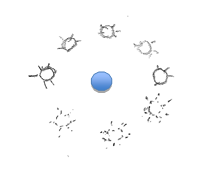
- How can you move your fist to act out this model?
- In the northern hemisphere where we live, stand facing South. East is to the left; West is to the right.
In the southern hemisphere, stand facing North. East is to the right; West is to the left. - Make a fist to represent the Sun.
- Point your fist horizontally toward the east to represent the rising Sun.
- Move your fist upward in an arc until it is pointing high to represent the sun moving toward being high in the sky at noon.
- Continue moving your fist in a downward arc until it is pointing horizontally toward the west to represent the setting Sun.
- Continue moving a fist in an arc down behind your back toward what can be thought of as the Sun’s position at midnight (change fists to do this).
- Move your fist in an arc up until it is pointing horizontally at the Sun’s rising position in the east (change fists to do this).
- In the northern hemisphere where we live, stand facing South. East is to the left; West is to the right.
- What evidence supports this model?
- What do you see if you keep track of where the sun seems to be in the sky during the day?
- What perspective do you hear if someone uses language such as sunrise and sunset to refer to the sun’s apparent daily arrival and departure?
- How are people acting if they look toward where the sun ‘is’ in the sky in order to estimate the time?
- On what basis have instruments like a sundial been designed? For a sundial simulation, see: https://www.britannica.com/technology/sundial. For information about ancient sundials, see http://sundials.org/index.php/all-things-sundial/ancient-sundials ).
These all reflect a model of the Sun revolving daily around a fixed Earth.
This is a very helpful model! We used it ourselves, along with the angle formed by pointing one arm at the Sun and the other arm at the Moon, to make predictions about when and where to look for each phase of the Moon. To make a sun clock, we labeled the positions where we see the Sun in the sky with the associated times and continued the pattern of such associated times when we envisioned the Sun continuing to move in a circle below the horizon as shown in Fig. 5.23 (repeated).
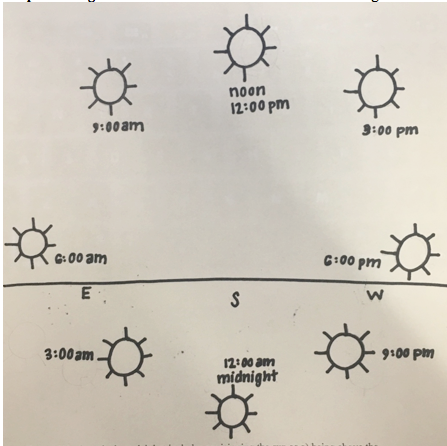
People have believed in this model, that the Earth is at rest in the center of the universe, for thousands of years. Aristotle, a Greek philosopher (384 BC – 322 BC), for example, built upon earlier ideas by Plato and Eudoxus to propose that the Moon, Sun, planets, and fixed stars all revolve around the Earth on a series of concentric transparent crystalline spheres. (see: http://www.pas.rochester.edu/~blackman/ast104/aristotle8.html).
Ptolemy, a Greek astronomer who lived in Egypt during the 2nd century (85-165 AD), tried to summarize everything known about astronomy at that time. He presented a complex mathematical Earth-centered model that predicted well the motions of the Sun, Moon, planets and stars (see: http://astronomy.nmsu.edu/geas/lectures/lecture11/slide01.html . His writings, a series of books known as the Almagest, were accepted for about 1400 years.
B. Developing the Fixed Sun, Rotating Earth explanatory model for day and night
An alternative model is harder to envision. How might the Earth be moving that makes the Sun seem to be revolving daily around the Earth? If a lamp representing the Sun is fixed in place, how can you move yourself to make the lamp seem to appear and disappear? Spin! By spinning your body around in a circle, you can make the lamp seem to ‘rise’ and ‘set’.
As shown in Fig. 5.25, a spinning Earth represents the fixed Sun, rotating Earth explanatory model for day and night.
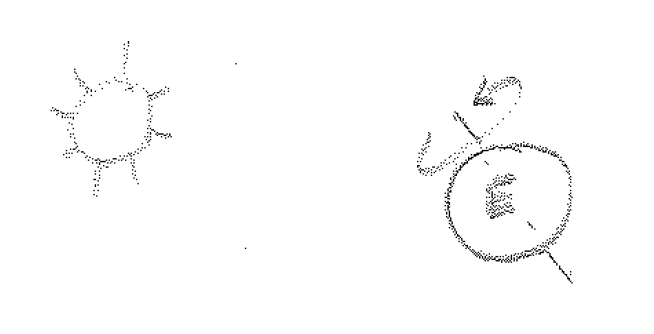
- How can you move your body to act out this model?
- Stand with both arms forming a horizon by being stretched out horizontally at your sides, with your head facing forward. Move so that the lamp seems to be rising, transiting, and setting although it remains fixed in place.
- Start by standing with a hand pointing at a lamp representing the Sun; this represents your position on a rotating Earth for which the Sun is just coming into view at the eastern horizon at about 6 a.m.
(In the northern hemisphere where we live, point East with your left hand; in the southern hemisphere, point East with your right hand.) - Continue holding your arms out horizontally at your sides while turning your body until you are facing the lamp; this represents your position on a rotating Earth for which the Sun appears to be high in the sky at about noon.
- Continue turning your body until your other hand is pointing at the lamp; this represents your position on a rotating Earth for which the Sun is passing out of view at the western horizon at about 6 p.m.
- Continue turning your body until your head is facing away from the lamp; this represents your position on a rotating Earth for which the Sun is completely out of view at about midnight.
-
- Continue turning your body until your hand is again pointing east at the lamp; this represents your position on a rotating Earth for which the Sun is just coming into view again in the eastern horizon at about 6 a.m.
- What evidence supports this model?
None to which we have direct access in this course. So far, this is just a theoretical idea that we have been acting out with the movements described above.
An everyday way to help students visualize the Fixed Sun, Rotating Earth model, however, is to take advantage of equipment frequently found in classrooms: a globe of the Earth.
- Tape a stick figure on the globe, at the place representing where you live
- Turn out the lights, turn on a lamp without a shade, spin the globe and watch the stick figure spin in and out of the light shining on it from the lamp.
Note that this is another illustration of the proposed model of a rotating Earth rather than evidence that supports its confirmation.
This is known as the heliocentric model. The prefix helio- refers to the Sun and centric refers to something that is at the center, something around which other things revolve.
Later in this course, you will develop a logical argument in favor of the Fixed Sun, Rotating Earth model. Meanwhile, here is some information about physical evidence for the Fixed Sun, Rotating Earth model that can be obtained with resources outside this course:
- To observe an effect of the rotation of the Earth, visit a Foucault pendulum as shown in Fig. 5.26. (See https://en.wikipedia.org/wiki/List_of_Foucault_pendulums for suggestions of where one can see such a pendulum. There is one, for example, at the Portland Oregon Convention Center, https://www.youtube.com/watch?v=6oYvffE6iGY , http://www.seattleastronomy.com/blog1/2011/10/the-worlds-biggest-foucault-pendulum/) Watch as a pendulum on a long cable swings back and forth. After a while the pendulum will appear to be swinging in a different direction as the floor has rotated underneath it as indicated by the fallen pegs in Fig. 5.26.
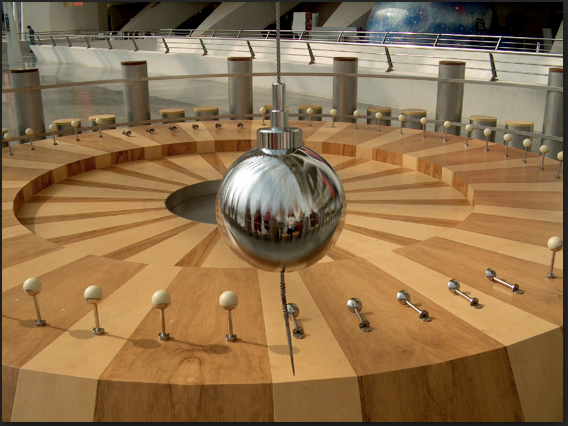
- To watch a Foucault pendulum in action via the Internet (see: https://www.geophysik.uni-muenchen.de/outreach/foucault-pendulum or this one at the Science Museum of Valencia, Spain https://www.youtube.com/watch?v=0cJosxIWISo ). Léon Foucault (1819-1868) demonstrated the Earth’s rotation in this way in Paris in 1851 (https://www.aps.org/publications/apsnews/200702/history.cfm).
Another effect of the Earth’s rotation involves weather. Storms in the northern hemisphere swirl counterclockwise whereas those in the southern hemisphere swirl clockwise. Gustave Coriolis, (1792-1843), a French mathematician and engineer, explained this effect. For information about the Coriolis effect, see: https://www.youtube.com/watch?v=i2mec3vgeaI and https://www.nationalgeographic.org/encyclopedia/coriolis-effect/
For a real-time demonstration of the Coriolis effect, download a free version of the app my radar, open, scroll through “layers” until you see “wind,” click on wind, broaden the view until you can see the oceans in both hemispheres and watch how the winds swirl. The red dots indicate earthquakes.
- How do the wind patterns shown in Fig. 5.27 indicate where the equator is?
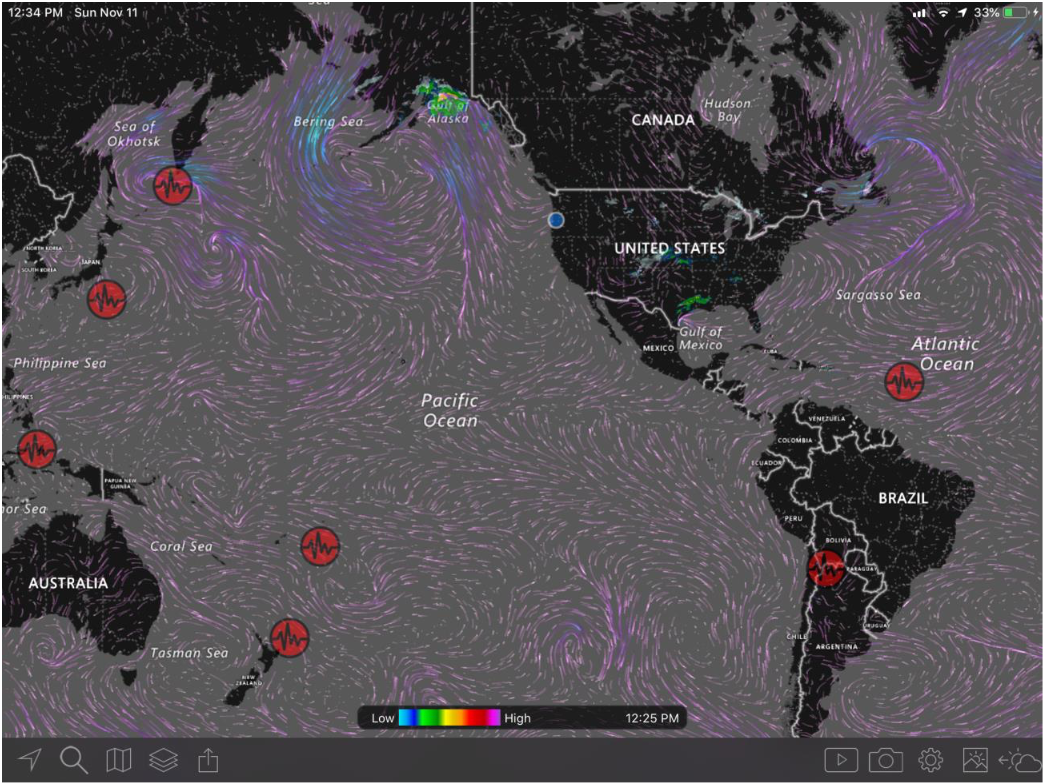
See https://www.jpl.nasa.gov/spaceimages/details.php?id=pia20365 for examples of ways that such wind diagrams can help develop understandings of El Niño events.
- Make sketches illustrating the two explanatory models for day and night.
- Also complete entries in Table V.3. Then write a summary of what you have learned before reading an example of student work about explanatory modes for day and night. Also available is a brief introduction to historical interpretations of these phenomena.
| TABLE V.3 Developing Two Explanatory Models for Day and Night/th> | |||
|---|---|---|---|
| URL/Sketch of set up | Evidence | Central Ideas | Relevant Vocabulary |
| http://www.polaris.iastate.edu/ EveningStar/Unit2/unit2_sub1.htm |
Fixed Earth, Revolving Sun Explanatory Model:
Sun seems to move east to west, revolving around the Earth each day. Moon, planets, stars also seem to do this. |
Aristotle (384-322 BC)
Ptolemy Sun clock model |
|
| http://ian.umces.edu/blog/2014/01/14/ nicholas-copernicus-and- the-copernican-revolution/ (scroll to assumption #5) https://www.classzone.com/books/earth_ science/terc/content/visualizations/ es0403/es0403page01.cfm?chapter_ no=visualization http://education.nationalgeographic.com/ |
Fixed Sun, Rotating Earth Explanatory Model:
Sun seems to be fixed. Moon, planets, stars also seem to be fixed over 24 hours Earth rotates on its axis. |
Copernicus (1543 AD published book)
Foucault pendulum Coriolis effect Spinning globe model Rotate Heliocentric model |
|
1. Example of student work about developing two explanatory models for day and night
In representing the Fixed Earth, Revolving Sun exploratory model as shown in Fig. 5.28, the student drew a stick figure to represent a person on a fixed earth. An arm points to the east, where the Sun seems to rise; next the arm points high in the sky, where the Sun seems to be about noon; and then the arm points to the west, where the Sun seems to set. To complete this representation, the arm finally swings down and around back up to the rising position in the east to represent the Sun continuing its journey below the horizon
In representing the Fixed Sun, Rotating Earth explanatory model, the student wrote, Sun represented by light on stool, moon represented as basketball held in one place. I am earth and I rotate counterclockwise. Left hand = rising, facing = high, right hand = setting; *facing south.
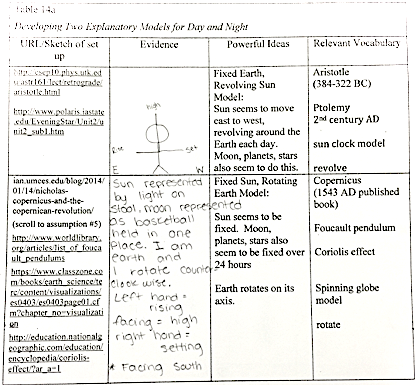
Developing two explanatory models for day and night. …we discussed two explanatory models for day and night. We demonstrated these ideas by using our arms, a basketball, a light, and…our bodies to represent the Sun, the Moon, and the…earth.
A Fixed Earth, Revolving Sun Model can explain day and night. As we have observed, the sun seems to rise in the east, move high across the sky, and set in the west. During this motion we stay ‘right here’ on a fixed earth. This sounds familiar because this model is what we typically think: the sun rises and sets…In class we modeled this by pointing one arm out with our hand representing the sun and then moving that arm in a circle to represent the sun rising, high in the sky, and setting.
A Fixed Sun, Rotating Earth Model also can explain day and night. In this model the Sun is thought of as “just there” and we on the earth are moving. We modeled this in class by holding both arms straight out to our side, with one pointing at the lamp, then rotating in place so that the lamp (sun) seemed to rise, be high in the sky, and set while we spun around. First one arm pointed to the lamp (rising) and then (we were) facing the lamp (noon) and the other arm pointed to the lamp (setting) and then (we were) facing away from the lamp (midnight) and continuing to turn so the other arm was once again pointing at the lamp (rising).
Physics student
2. Interpreting two different models for the same phenomenon
Having two different models that explain the same phenomenon frequently occurs as one is exploring something of interest systematically. Eventually arguments based on evidence may lead to confirming one explanation as more likely than the other. However, both can be useful in particular contexts.
When enjoying a beautiful sunset, for example, it is easy to “see” the Sun sinking toward the horizon and hard to envision oneself instead as whizzing by a fixed Sun. The Fixed Earth, Revolving Sun model seems attractive in that one can daily observe the Sun apparently rising, moving high across the sky, and setting instead of thinking of oneself as spinning by the Sun while on the surface of a rotating Earth. The Fixed Earth, Revolving Sun model also can be useful, as in our formal process for predicting when and where to look for the Moon as summarized in Table V.1.
The history of ideas about the Earth’s rotation is connected to ideas about the Earth’s relation to the Sun. In the early 1500’s, a Polish astronomer, Nicholas Copernicus (1473-1543), wrote in Latin about his assumptions that the Earth spins on its axis as it revolves around the Sun, rather than the firmament (sun, moon, planets, and stars) revolving around the Earth:
- Whatever motion appears in the firmament arises not from any motion of the firmament, but from the earth’s motion. The earth together with its circumjacent elements performs a complete rotation on its fixed poles in a daily motion, while the firmament and highest heaven abide unchanged. (translation)
- What appear to us as motions of the sun arise not from its motion but from the motion of the earth and our sphere, with which we revolve about the sun like any other planet. The earth has, then, more than one motion. (translation)
Nicolaus Copernicus, Commentariolus
(http://ian.umces.edu/blog/2014/01/14/nicholas-copernicus-and-the-copernican-revolution/).
This perspective was so controversial, however, that Copernicus did not publish his ideas until 1543. His book On the Revolutions of the Heavenly Sphere appeared shortly before his death.
Almost a century later, in 1632, Galileo (1564-1642) published a book, Dialogue, later titled Dialogue Concerning the Two Chief World Systems, in which he presented a discussion among three individuals about the generally accepted geocentric Ptolemaic system and the heliocentric Copernican system. In 1633, the Roman Catholic Church banned Galileo’s writings, including this book, and placed him under house arrest until his death in 1642.
During the 350th anniversary of Galileo’s death, in 1992, Pope John Paul II addressed the Pontifical Academy of Sciences about “the Galileo case.” He reported the findings of a committee that had concluded that Galileo’s preference for the Copernican perspective was correct. (See https://www.nytimes.com/1992/10/31/world/after-350-years-vatican-says-galileo-was-right-it-moves.html ). In his speech to the Academy, Pope John Paul II said,
12. Another lesson which we can draw is that the different branches of knowledge call for different methods. Thanks to his intuition as a brilliant physicist and by relying on different arguments, Galileo, who practically invented the experimental method, understood why only the Sun could function as the centre of the world, as it was then known, that is to say as a planetary system. The error of the theologians of the time, when they maintained the centrality of the Earth, was to think that our understanding of the physical world’s structure was, in some way, imposed by the literal sense of the Sacred Scripture. Let us recall the celebrated saying attributed to Baronius: “Spiritui Sancto mentem fuisse nos docere quomodo ad coelum eatur non quomodo coelum gradiatur.”* In fact the Bible does not concern itself with the details of the physical world, the understanding of which is the competence of human experience and reasoning. There exist two realms of knowledge, one which has its source in Revelation and one which reason can discover by its own power. To the latter belong especially the experimental sciences and philosophy. The distinction between the two realms of knowledge ought not to be understood as opposition. The two realms are not altogether foreign to each other; they have points of contact. The methodologies proper to each make it possible to bring out different aspects of reality.
Pope John Paul II, 1992
Pope John Paul II, Address to the Plenary Session on ‘The Emergence of Complexity in Mathematics, Physics, Chemistry and Biology’ 31 October 1992, (Vatican City: the Pontifical Academy of Sciences). http://www.accademiascienze.va/content/accademia/en/magisterium/johnpaulii/31october1992.html
*Galileo also had quoted this saying in a letter to the Grand Duchess Christina of Tuscany in 1615: I would say here something that was heard from an ecclesiastic of the most eminent degree: “That the intention of the Holy Ghost is to teach us how one goes to heaven, not how heaven goes.” (lines 373-376, bottom of page 5) https://hti.osu.edu/sites/hti.osu.edu/files/galileo_galilei.pdf
In this address, Pope John Paul II drew a clear distinction between the realm of religious faith and the realm of the experimental sciences while offering respect for both. The methodology of science involves making claims based on evidence and presenting arguments that explain the rationale for why the evidence supports the claim.

